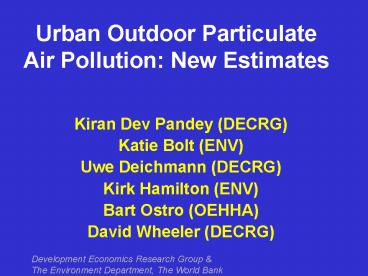Development Economics Research Group - PowerPoint PPT Presentation
1 / 22
Title:
Development Economics Research Group
Description:
Kirk Hamilton (ENV) Bart Ostro (OEHHA) David Wheeler (DECRG) Development Economics Research Group ... Lack of city specific environmental indicators are a ... – PowerPoint PPT presentation
Number of Views:37
Avg rating:3.0/5.0
Title: Development Economics Research Group
1
Urban Outdoor Particulate Air Pollution New
Estimates
- Kiran Dev Pandey (DECRG)
- Katie Bolt (ENV)
- Uwe Deichmann (DECRG)
- Kirk Hamilton (ENV)
- Bart Ostro (OEHHA)
- David Wheeler (DECRG)
2
Key Points of the Presentation
- Lack of city specific environmental indicators
are a detriment to effective action. - World Bank has developed a model to estimate PM10
concentrations for all world cities larger than
100,000. - Health Impacts of urban particulate matter
outdoor air pollution are substantial. - The dissipative capacity of the environment is
significantly different across cities. National
urban policy needs to incorporate differential
shadow prices.
3
Health Impacts of PM Air Pollution
- Most Health Impacts of air pollution are from
fine particles PM2.5/PM10 not from coarser TSP,
SOx, NO2 - Particulate Emissions has been linked to
mortality and morbidity - Cardiopulmonary diseases
- Lung Cancer
- Acute Respiratory Infection
4
Health Impacts of Air pollution
- WHO estimates 800,000 (range 530,000 to
1,260,000) worldwide deaths per year from
background level of ambient PM pollution. - Health Impact Estimates based on World Bank PM10
estimates for 3200 cities worldwide. - Health Impacts would be even higher if impacts
from exposure to high concentration
microenvironments such as along transport
corridors or industrial districts were included.
5
Developing Air Pollution Policy
- Pollutant Ambient Concentrations
- Spatial Exposure Model
- Health Impacts Estimate
- Economic Valuation of Impacts
- Cost Benefit Analysis of Policies
6
Developing Air Pollution Policy
- Emission Inventory
- Spatial Dispersion Model
- Pollutant ambient concentration (benchmark)
- Spatial Exposure Model
- Health Impacts Estimate
- Economic Valuation of Impacts
- Cost Benefit Analysis of Policies
7
Cities with Monitored PM Data
8
Availability of Monitored PM Data by WHO
Sub-Region
9
Model of Ambient PM
Anthropogenic Scale of Economic
Activity Composition of Economic Activity Density
of Economic Activity Emissions Abatement Policy
Ambient PM
Environment Dissipative Capacity
10
Model of Ambient PM
- Regression model of PM based on available
monitored ambient city data - Determinants of ambient PM
- Fuel consumption mix
- Local economic activity intensity
- Population density
- Income per capita
- Meteorological and topographic variables
- Country specific factors
11
Estimation Approach
- Explains 88 of observed variation
- Details in Pandey K.D. et al (forthcoming 2002)
- Estimated in 2 stages to take advantage of panel
- Marginal effect city model (with country fixed
effect) - Cross-section model for average effect
- Uses information about site location
- Joint estimation of PM10 and tsp at residential
and non-residential sites
12
Model Predictions
- Model was used to predict PM10 levels for all
world cities with 100,000 people or more and
national capitals. - Uncertainty estimates were also developed
13
Availability of Exposure Data
14
Estimated PM10 Concentration in World Cities
(pop100,000)
15
Anthropogenic Contribution to PM10
16
City Vulnerability to PM10
17
Vulnerability to Air Pollution
Within India quintiles i.e., the class breaks
are a bit different from the global quintile
breaks.
18
WHO Collaboration
- PM10 Model Predictions used as basis for WHO
Comparative Risk Assessment of Different Risk
Factors and the Global Burden of Disease Study - Published in the World Health Report 2002.
19
No of Deaths (1000s) from Outdoor PM
Pollutionby WHO Sub-Region
Subregion Mortality stratum (chld/adlt)
20
Dalys (1000s) from Outdoor PM Pollution by WHO
Sub-Region
Subregion Mortality Stratum (chld/adlt)
21
Fraction of Cardiopulmonary Deaths Attributed to
Outdoor PM Pollution by WHO Sub-region
Subregion Mortality Stratum (chld/adlt)
22
Incorporation in World Bank Operations
- Environmental Monitors Thailand, Philippines
- Incorporation into CAS
- Economic Losses implied by health outcomes
incorporated in National Genuine Savings
accounting - Publication in WDI/Little Green Book
23
Conclusions
- Localized environmental indicators necessary for
effective policies can be estimated using models
with geographic information system data. - Modeled data can
- Indicate need for more precise information,
- Provide incentives for immediate action.
24
Conclusions (continued)
- Health Impacts of urban particulate matter
outdoor air pollution are substantial. - The dissipative capacity of the environment is
significantly different across cities. National
urban policy needs to incorporate differential
shadow prices.

